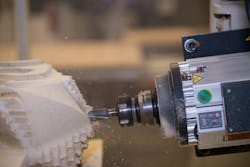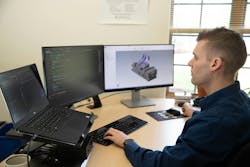The Role of CAM in Sustainable Manufacturing
Computer-aided manufacturing (CAM) software helps multidisciplinary engineers take digital designs to physical products, all while addressing environmental sustainability. With advanced toolpath optimization and smart material utilization, CAM programming can help reduce waste and boost precision, which results in less scrap, fewer errors and a more efficient use of resources.
Machine Design spoke with Jesse Trinque, a product marketing engineer at Mastercam, about the environmental impacts of CAM usage. In addition to driving down waste he said, “CAM software also can cut down on coolant usage and reduce energy consumption.”
This reduction in coolant and energy not only lowers operational costs but also diminishes the environmental impact of manufacturing operations. For example, when CAM systems optimize cutting paths for efficient material removal, the energy required to execute machining operations is greatly reduced.
Trinque suggests that there is potential for savings from dynamically optimized machining processes. “It’d be interesting almost to do a study and see...how many megawatts of power we save in electricity just from one toolpath,” he said.
Integrating CAM and CAD, Advanced Technology
The integration of CAM with computer-aided design (CAD) software promotes a streamlined workflow from conception to production for mechanical and design engineers. By using direct data transfer and revisions between design and manufacturing teams, engineers can reduce lead times.
Trinque says it is important to recognize the “purposeful disconnect between CAD and CAM,” too. For complex components that require intricate designs—such as aerospace or automotive parts—specialized knowledge is needed. Design engineers might lack the programming expertise or understanding of machining methods necessary to prepare a CAM program correctly.
“If I’m the guy designing the aircraft engine, I do not want a machinist making modifications or a programmer making modifications to my blade that has a very specific set in that CAD model,” Trinque said. This shows a need for clear communication, a delineation of roles and cross-disciplinary knowledge to ensure high-quality outputs.
The ongoing advancements in automation, artificial intelligence (AI) and machine learning might be the future of CAM technology, but Trinque cautions that they are still “very far from mature.” Current AI capabilities in manufacturing often focus on automating routine processes, he says, adding that they have yet to reach the sophistication needed to replace the nuanced human judgment required in complex design tasks.
Trinque points out that seeing the evolution of consumer-grade 3D printing technology is a good example of automation’s potential in manufacturing. As AI tools develop, they might streamline process efficiency as well as the accuracy of machining while freeing engineers to engage in conceptual and design aspects rather than repetitive programming tasks, he says.
The integration of machine learning algorithms can help improve toolpath generation, too, he says, optimizing feed and speeds based on real-time data as well as predict maintenance needs to minimize machine downtime. Leveraging AI could lead to an “incredibly powerful” CAM system capable of making adjustments based on empirical performance metrics, he said.
CAM Challenges and Solutions
Despite its many benefits, there is a learning curve associated with using CAM. “It’s not an easy thing to jump right in to program a CNC machine,” Trinque said. Mastercam redesigned the user interface to be more intuitive and accessible, he said, and they now use a “Microsoft-like” interface, which allows users who are familiar with standard software applications to engage with CAM systems more easily.
The company also offers an education initiative to introduce students and new engineers to CAM technology early in their careers. By developing a “full online Mastercam University,” Trinque says they want to shorten the learning curve and ensure that the next generation is equipped with the necessary skills.
“CAM software is not one of those things that you sell it and say goodbye,” Trinque noted. Providing continuous instructional support helps ensure that users can troubleshoot effectively and maximize their software usage.
About the Author
Sharon Spielman
Technical Editor, Machine Design
As Machine Design’s technical editor, Sharon Spielman produces content for the brand’s focus audience—design and multidisciplinary engineers. Her beat includes 3D printing/CAD; mechanical and motion systems, with an emphasis on pneumatics and linear motion; automation; robotics; and CNC machining.
Spielman has more than three decades of experience as a writer and editor for a range of B2B brands, including those that cover machine design; electrical design and manufacturing; interconnection technology; food and beverage manufacturing; process heating and cooling; finishing; and package converting.
Email: [email protected]
LinkedIn: @sharonspielman
Facebook: Machine Design
YouTube: @MachineDesign-EBM


